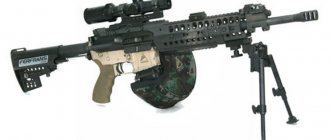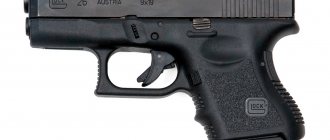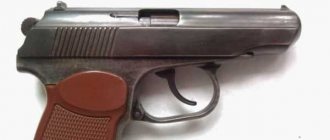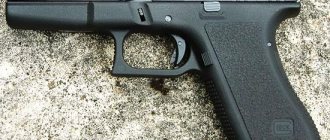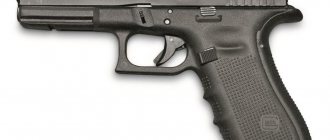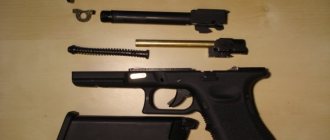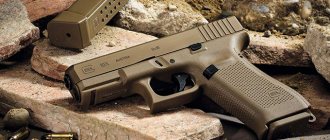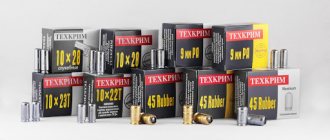Glock 43 pistol
Glock 43
In 2014, after a long break in the development of pistols, it released two new models onto the world arms market - the practical-tactical Glock 41 in .45 ACP caliber and the subcompact Glock 42 in .380 ACP caliber.
| Caliber, mm | 9x19 |
| Length, mm | 159 |
| Width, mm | 26 |
| Height with magazine, mm | 108 |
| Barrel length, mm | 86 |
| Shutter housing length, mm | 154 |
| Aiming line length, mm | 132 |
| Weight, kg - without magazine - with empty magazine - with loaded magazine | 0.459 0.509 0.584 |
| Store, count. cartridges | 6 |
| Initial bullet speed, m/s | 340 |
When the G42 was released in .380 ACP, the most popular review was something like, “I wish this model had a single-stack 9mm magazine.” The Glock company heard this wish and in March 2015 released the Glock 43 model chambered for a more powerful 9x19 mm cartridge.
The Glock 43 pistol became the second subcompact model chambered for the 9x19 mm cartridge. The first pocket model, the Glock 26, chambered for this cartridge, was created in 1995.
Structurally, the Glock 43 is a symbiosis of the G26 and G42 models. The internal design of the new pistol remained from the 26th model, and the main changes and single-stack magazine came from the 42nd model, developed according to the standards of the fourth generation (Gen 4) of this weapon. At the same time, the 43rd Glock has become significantly lighter than the Glock 26 model.
The Glock 43 automatic operates due to the recoil of the barrel during its short stroke. The barrel bore is locked by the upper protrusion of the barrel entering the ejection window of the spent cartridges of the bolt casing. The barrel bore is unlocked by lowering its breech down using the lower breech boss and axis during recoil of the barrel. The telescopic return spring rod consists of an outer tube and an inner axle, on which two springs are located - one on the tube, the other on the axle.
Glock 43 (top view)
The trigger mechanism is of the striker type, the so-called “safe action” (Safe Action). A special feature of this trigger is that during the reloading cycle of the pistol, the firing pin is only partially cocked, while it is blocked using an automatic safety lock. The firing pin is re-cocked only when the trigger is pressed, while the firing pin remains blocked from moving forward until the trigger is fully pulled. Thus, it is possible to achieve a uniform force on the trigger from the first to the last shot, which has a positive effect on shooting accuracy.
Glock 43
The pistol is equipped with three independently operating fuses. An automatic firing pin safety prevents the firing pin from striking the cartridge capsule in the event of an accidental de-cocking of the sear. The anti-shock fuse prevents the cocking sear from being torn off during an external impact. The trigger safety locks the trigger and releases it only with a conscious pull.
The trigger pull is 2.5 kg and can be adjusted from 2 to 4 kg.
The ejector, in addition to its main function, is also an indicator of the presence of a cartridge in the chamber.
The weapon is fed with ammunition from a detachable box magazine with a single-row arrangement of 6 rounds. The magazine latch is located at the base of the trigger guard.
The barrel has a right-hand hexagonal rifling, as well as the bolt casing and is treated with a special tennifer coating.
The U-shaped shutter casing is made of steel using high-precision casting and subjected to special treatment to increase corrosion and wear resistance.
The frame is made of high-strength polymer material. The guide frames along which the steel casing-shutter moves are reinforced with steel inserts. The ergonomically shaped handle has a short length; The back of the handle is made with a “beaver tail” extension.
On the left side of the frame there is a small shutter stop lever.
Above the trigger guard there is a double-sided barrel lock. Glock 43 (rear view)
Open sights are mounted on the flat top surface of the bolt housing and consist of a replaceable front sight for vertical adjustment and a replaceable rear sight mounted in a transverse dovetail groove. Standardly, the front sight is equipped with a luminous dot, and the rectangular slot of the rear sight is framed by a luminous frame.
All metal parts of the weapon are processed using Tennifer technology. As a result of this treatment, the surface to a depth of 0.05 mm acquires a hardness of about 69 Rockwell units (for comparison, the hardness of industrial diamonds is 71–72 units).
The subcompact Glock 43 pistol chambered for 9x19 mm is intended for use as a concealed self-defense weapon, as well as for use as a backup service weapon. It was Glock's first 9mm pocket pistol to feature a single-stack magazine. The Glock 43 is an excellent combination of the bullet stopping power of the cartridge used and the excellent performance of the weapon itself. Despite its small size and weight, it has the same high qualities as all models of the Glock family - simplicity, convenience and safety in handling, ease of maintenance, long durability and very high reliability in difficult operating conditions, and compactness and lightness made constant concealed carrying comfortable and tire-free.
Partial disassembly of Glock 43
Glock tests under different conditions
It is necessary to mention the series of tests that the production Glock 17 successfully passed.
- Ice: The pistol with loaded magazine was frozen in an ice cube for 60 days. After that, he was removed from the ice and 100 shots of 10 rounds were fired.
- Mud: The gun was lubricated, closed and immersed in mud of various consistencies: dry sand, clay, wet river sand. After each such procedure, repeated 5 times, 100 shots were fired.
- Mud: The gun was completely wetted with water and immersed in river mud. After shaking the gun once with the remaining sludge, 10 series of 10 shots were fired.
- Water: The fully loaded pistol was immersed in water to a depth of 1 meter for 1 hour, then the pistol was removed from the water and 10 series of 10 shots were immediately fired.
Durability: A loaded pistol was placed on coarse gravel and then driven over by a heavy truck. The truck was then left parked with its wheel on the gun for an hour. After this, 100 shots were fired. All tests were carried out in the specified sequence with the same pistol and one magazine. There were no delays in any of them.
Every Glock pistol is tested by firing high power test cartridges that create high pressure in the bore. Practice has confirmed that Glock can withstand almost twice the pressure. The weapon has a large durability resource. Some pistols remained functional after hundreds of thousands of rounds.
The practice of regular shooting by the owners of these pistols over a long period of time, as well as shooting underwater and long-term shooting without cleaning and lubricating the weapon, confirms the highest resistance to corrosion of all parts - Glock does not rust. As for survivability and service life, the products of the Austrian company set simply amazing records. The pistol's warranty life is 40,000 shots, but factory tests have shown that the Glock 17 can withstand more than 360,000 shots without mechanical failure of the main parts of the weapon.
Chuck Taylor, a weapons expert and renowned journalist, has already fired more than one million rounds of ammunition from his Glock! Overall, Glock pistols are very practical, excellent weapons in all respects, and are the best choice for both police, military and special forces soldiers, as well as for ordinary citizens who use a pistol for self-defense or who are interested in sports shooting.
At the end of 2009, the company began producing the fourth generation of Glock pistols, designated Gen 4, which were presented at the 2010 SHOT Show in Las Vegas. The first Gen 4 models were the fourth generation Glock 22 and Glock 17 pistols, designated Glock 22 Gen 4 and 17 Gen 4, respectively. The main innovations of Gen 4 were: replaceable panels on the back of the handle; new handle surface texture; two return springs; narrower handle; an enlarged magazine release with a larger contact area that can be moved to the right side of the pistol frame; On the left side of the bolt housing, behind the stylized company logo and model number, there is the designation Gen 4.
Practical use
Well, what can you say - Glock, it is Glock. You take it in your hand and you are immediately convinced of it. Everything is familiar and understandable from previous models - the same plastic, all the same buttons and keys in their places, the same manipulations during assembly/disassembly, the same characteristic trigger, the same sights. Everything is the same - only the pistol itself is much thinner, lighter, more elegant. And only an understanding of its “filling” - the capabilities of the standard NATO cartridge and the most common pistol ammunition in the world, 9x19 Luger - does not allow us to treat this Glock as a toy. As soon as I took it in my hand, I was immediately ready to load the magazine, pull the bolt with a large notch in the back and shoot. But an even greater desire is to hide it in your pocket or tuck it into your belt to exclaim: “Ha! You can't see him at all! And I don’t feel it on myself at all!”
But the purpose of a pistol is to shoot. Shooting from the Glock 43, on the one hand, is not much different from shooting from other pistols of this brand and this caliber, but on the other hand, it is specific due to its compactness and weight. This weapon works fully at short and ultra-short distances (1-3 m) - both leisurely and at a good pace, with extraction and the first shot in less than two seconds, and a series of shots with splits (time intervals between two consecutive shots) about 0.25 s, and thoughtfully at distances up to 50 m. Low weight and size affect a sharper feeling of recoil and a greater bounce of the weapon after a shot. A couple of magazines released at a fast pace noticeably “dry” the brush, causing a feeling of slight discomfort. But this is a very reasonable price to pay for compactness.
